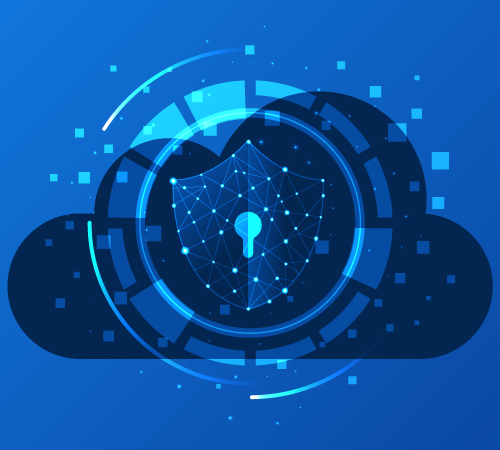A cloud security checklist is the first step for organizations to protect cloud-based data, infrastructure, and systems. Not only does implementing a cloud computing security system protect your data and secure your cloud, but it also ensures that your customers’ privacy remains intact.
With the increasing data breach threat, many small and large enterprises are concerned about the security controls of cloud applications. In this comprehensive guide, we’ll explore the security risks of moving data to the cloud network and some cloud security best practices for data loss prevention.
Security Risks Of Cloud Computing in 2023
Recent research from ISC2 reveals that around 93% of organizations are moderately or extremely concerned about their cloud environment security. Additionally, one in four enterprises said that some cloud security incident happened to their organization in the past 12 months.

The growing statistics in the public cloud security domain have become a significant concern for businesses. If your cloud resources are not well-secured, your cloud accounts are prone to SQL injection, malware, denial of service, sensitive data loss, etc. Therefore, when moving to the cloud, you should prepare yourself for a particular set of challenges and risks.
Remember, security risk does not mean cloud storage or computing is unsafe; instead, it means more protection than on-premise setup. Many cloud service providers help you access highly sophisticated network security tools, so you can prevent unauthorized access to sensitive information that enters the cloud. Below we’ve mentioned a few security risks that one must acknowledge while creating the cloud security best practices checklist.
Loss Of Visibility
Accessing a range of cloud services through multiple devices can lead to complexity in the cloud computing setup. Without the appropriate tools, you can lose infrastructure visibility and make your business prone to security concerns. Furthermore, organizations lose their understanding of what data they are accessing, uploading, and downloading.
Compliance Violation
When transferring volumes of data to the cloud, it’s vital to adhere to a broad range of stringent cloud compliance requirements. Some regulations include understanding what your data is, how it is processed, and how it is protected. Moving to the wrong cloud provider or careless transfer can also introduce serious financial repercussions.
Cloud Service Misconfiguration
Another potential cloud security risk is the misconfiguration of cloud service. The complexity and wide range of services lead to the misconfiguration of cloud services. It can make your data publicly exposed, deleted, and even manipulated.
Insecure Application User Interface
In order to operate systems in the cloud infrastructure, organizations need to use an API to implement security control. However, external-facing APIs can introduce a cloud security risk and offer unauthorized access to cyber criminals.
Contractual Breaches
A contractual partnership includes restrictions on the cloud usage, storage, and access authorization of shared data. Sometimes employees unwittingly move the restricted data into the cloud service. As a result, transferring data without consent could create a breach of contract, which could lead to legal action.
In order to migrate on-premise to the cloud without data breach risk, it’s vital to keep these security concerns in mind and prepare a migration plan with Inferenz experts.
Cloud Security Best Practices Checklist
Now that you know the security risks, it’s best to understand some cloud security best practices.
Choose Trusted Cloud Provider
The foundation of cloud security best practice involves selecting a trusted service provider. Partnering with a service provider that delivers the best in-built security protocols helps mitigate the chances of breaches and secure the cloud. Some leading cloud platforms with the best security systems in 2023 include Amazon Web Services, Azure, and Google Cloud Platform.
Understanding Shared Responsibility Model
Whenever an organization partners with a cloud service provider, both parties enter into a partnership of shared responsibility model. Understanding the model is vital to creating a cloud security checklist and being safer. Discovering the distribution of security tasks between you and your cloud provider will help mitigate the security risks and bring transparency and clarity.
Implement Encryption
Every organization should follow the best cloud security practice step of encrypting data. When using cloud services, your data is exposed to increased risk. Sending data back and forth between on-premise networks and cloud services can increase the chances of data breaches and data loss. The highest encryption levels at transit and rest protect your data from third-party attacks.
Implement a Strong Password Security Policy
Another cloud services-based security solution includes implementing strong passwords. All your passwords should have a minimum of 14 characters, including one upper-case letter, one lower-case letter, one number, and one symbol. A strong password policy will stop users from creating simple passwords and defend against brute force attacks.
Protect Your Cloud Data With Experts
When adopting cloud technology and selecting a service provider, one of the most critical factors that need to be considered is security. You’ll share and store your company’s data with your cloud provider. That’s why it’s worth noting the security requirements in the initial phases and following best practices to avoid security compromises.

If you’re looking to up the game of your cloud security, contact Inferenz experts today. Our cloud data and migration experts can help prepare the cloud security checklist and mitigate security issues during data transfer.
FAQs
What are the top 5 security issues in cloud systems?
This includes data loss, denial of service attacks, data privacy, incident response, and accidental exposure of credentials.
What are the three measures to secure the cloud?
Authentication and identity, secure deleting, access control, data masking, etc., are all important for securing your cloud environments.
What does the NIST cloud security audit checklist include?
The NIST cloud security assessment checklist includes multi-factor authentication, mobile management, message encryption, external sharing standards, anti-phishing protections, etc.













